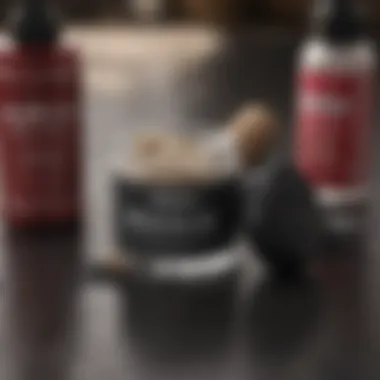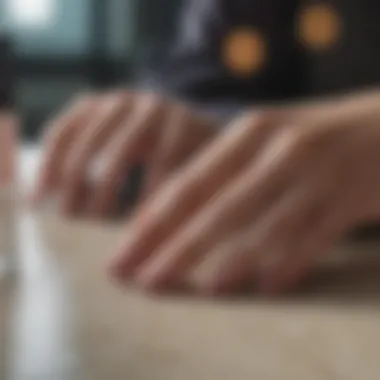Mastering Dip Polish Removal: Your Essential Guide


Intro
The process of removing dip polish deserves attention, as it directly influences not just the aesthetics of nails, but also their health. Dip polish, known for its durability and shine, can often be tricky to take off. Understanding how to effectively and safely remove it is crucial for anyone who regularly uses this manicure technique. This guide delves into various methods, tools, and aftercare required to ensure a smooth transition, whether you are opting for a fresh start with natural nails or considering an alternative polish.
Fashion Trends
Seasonal Styles
Nail trends vary with the seasons, yet removing dip polish remains a staple concern across the board. As seasons change, so do styles. Bright, bold colors tend to dominate during summer, while more muted shades grace the winter months. However, with dip polish, these seasonal changes can introduce buildup and potential damage. Therefore, being equipped with the right methods for removal allows individuals to embrace fresh styles without compromising nail integrity.
Influencer Inspirations
Social media influencers play a significant role in shaping nail art trends. Their creative combinations of colors and textures often highlight topical issues like dip polish removal. Many influencers have shared their processes for transitioning from vibrant dip nails to natural ones or new polishes, showcasing various techniques. Observing these methods can provide insight into effective techniques and inspire new ideas for one’s own nail care routine.
Techniques and Tools for Removing Dip Polish
Removing dip polish generally involves a few crucial tools and techniques.
At-Home Solutions
For those who prefer tackling dip polish removal at home, the following tools might be necessary:
- Acetone: A powerful solvent that breaks down dip polish effectively.
- Nail file: Useful for thinning out the layers of the polish, which makes it easier to remove.
- Cotton balls or pads: Needed for soaking and applying acetone.
- Foil: To wrap fingers, keeping acetone in contact with the dip polish.
Professional Options
Visiting a professional can also ensure optimal results. Many salons use electric nail files or specialized soak-off methods. Professionals have experience and knowledge of products that both work efficiently and protect the nails from damage.
Aftercare Tips
Once dip polish has been removed, aftercare is essential in preserving nail health. This includes:
- Moisturizing: Regularly apply cuticle oil and hand cream to restore hydration.
- Nail strengthening treatments: Options like Sally Hansen Hard as Nails can protect and strengthen the nails post-removal.
- Limiting exposure: Try to avoid excessive water exposure for the first few days after removal, as nails can become more prone to damage.
"The art of nail care lies not just in the beauty of the polish, but in the health of the nail underneath."
With this comprehensive understanding of removing dip polish, readers can appreciate the interlinked elements of nail maintenance, fashion trends, and health considerations. This knowledge empowers individuals to make informed choices in their nail care journey.
Understanding Dip Polish
Understanding dip polish is crucial for both the application and removal processes. Dip polish has gained popularity due to its supposed longevity and glossy finish. It allows for vibrant nail colors without the frequent touch-ups needed with traditional nail polishes. Consequently, knowing the ins and outs of this method plays a significant role in maintaining nail health and aesthetics.
What is Dip Polish?
Dip polish is a type of nail enhancement that is applied by dipping a nail into a colored powder after a base coat is brushed on. After dipping, a sealing top coat is applied. This method incorporates a combination of pigments, bonding agents, and activators to create a durable finish that can last several weeks. Dip powders come in a variety of colors and finishes, similar to traditional nail polishes but provide a thicker look and feel. The process is usually quicker than gel applications, which require UV curing.
Benefits of Dip Polish
The benefits of dip polish appeal to many users. Some of the main advantages include:
- Longevity: Dip polish can last anywhere from three to six weeks without chipping, making it a time-efficient option.
- Variety of Colors: The range of colors and finishes is extensive, so there is something for everyone.
- Less Odor: Dip polish typically has less odor compared to acrylics and traditional polishes, which can be a plus during application.
- Strengthening: The applied layers of dip polish can offer additional support to the natural nail, reducing breakage in some cases.
This method can be particularly beneficial for those who prefer low-maintenance manicures without sacrificing aesthetics.
Common Concerns with Dip Polish
Despite its advantages, there are common concerns related to dip polish that users should be aware of:


- Nail Damage: Prolonged exposure to dip polish can lead to weakened nails or difficulties in natural nail recovery if not removed properly.
- Chemical Exposure: The process often involves chemicals that can irritate sensitive skin or lead to allergic reactions in some people.
- Removal Challenges: Proper removal of dip polish requires specific techniques to avoid damaging the natural nail.
Educating oneself about these points ensures that the dip polish method is used effectively, minimizing any adverse effects while maximizing its benefits.
Preparing for Removal
The removal of dip polish is a necessary step in maintaining both the health of your nails and the overall aesthetics of your manicured look. Preparing for the removal process ensures that it is efficient and minimizes potential damage to your natural nails. This preparation involves gathering the essential tools and being aware of safety precautions. A thoughtful approach can lead to a less stressful experience and promote better outcomes following the removal.
Essential Tools for Removal
Using the right tools is crucial for effective dip polish removal. The following items are commonly recommended:
Acetone
Acetone is a solvent widely recognized for its effectiveness in dissolving dip polish. One of its key characteristics is its rapid evaporation rate, which makes it powerful yet requires cautious application. It is a popular choice because it generally works faster than other solvents. However, the main disadvantage is its drying effect on both skin and nails, necessitating careful aftercare. Ensure you have a properly ventilated space, as the fumes can be overpowering.
Nail File
A nail file plays a significant role in the removal process as it helps to thin down the dip polish before soaking. The key characteristic of a nail file is its abrasive surface, which enables users to carefully file down layers of polish. This tool is a beneficial choice because it allows for controlled removal, reducing the amount of time nails need to spend in contact with acetone. However, over-filing can damage the natural nail. Use caution and apply gentle pressure to avoid harm.
Foil Strips
Foil strips are often used in the soaking process to encapsulate the acetone-soaked cotton. The unique feature of foil strips is their ability to create a sealed environment that enhances the effectiveness of acetone. This method is helpful because it allows the acetone to penetrate the dip polish more efficiently. A disadvantage might be the hassle of wrapping and keeping the strips in place, but their usefulness in aiding the removal process is notable.
Cuticle Oil
Cuticle oil is not directly involved in the removal of dip polish but is essential for post-removal care. Its key characteristic is its moisturizing properties, providing hydration to the nails and surrounding skin. Cuticle oil is a beneficial choice as it helps to restore moisture lost during the acetone exposure. Regular application can strengthen nails and prevent dryness. Its main disadvantage is that it is often overlooked during the removal process, yet it plays a vital role in maintaining nail health afterwards.
Safety Precautions
When removing dip polish, safety should always be the priority. Working with acetone requires careful handling, as it can irritate skin and eyes. Keep the acetone away from flame, as it is highly flammable. Using gloves protects your skin, and working in a ventilated area reduces fume inhalation. Always have a first aid kit on hand in case of accidental spills or irritation. Taking these precautions enhances the removal experience, making it safer and more effective.
Remember: Preparation is key. Gathering your tools and understanding safety measures sets the stage for an effective dip polish removal.
At-Home Removal Methods
At-home removal methods provide a convenient option for people who regularly use dip polish. Knowing how to remove dip polish at home is vital for maintaining nail health and sometimes even saving money on salon visits. This guide outlines effective methods for removing dip polish while respecting the integrity of your nails. Each technique has its specific benefits and considerations, ensuring that you can choose a method that best suits your needs and preferences.
Soaking Technique
The soaking technique is one of the most popular methods for removing dip polish at home. This method involves soaking the nails in acetone, which is a powerful solvent that effectively breaks down the dip layers. The key to success with this technique is the use of cotton balls soaked in acetone, which are placed on the nails and wrapped in foil.
- Steps to Follow:
- Gather Your Materials: You will need acetone, cotton balls, aluminum foil, a nail file, and cuticle oil.
- Prepare the Nails: Start by filing the top layer of the dip polish to make it thinner. This process allows the acetone to penetrate more effectively.
- Soaking Process: Soak cotton balls with acetone and place them on the nails. Wrap each fingertip with a small piece of aluminum foil. Leave them on for about 10-15 minutes.
- Check the Progress: After the soaking time, remove the foil and cotton. The polish should easily lift off. If it does not, re-soak for a few more minutes.
It's important to keep your nails hydrated after using acetone, as it can be drying.
Filing Method
The filing method is a more manual approach to dip polish removal. This technique involves gently filing the dip polish off the nails without the use of acetone. While it can take longer than soaking, it is a less harsh option for those concerned about nail health.
- Steps to Follow:
- Use Proper Tools: A coarse nail file is essential for this method.
- Filing Technique: Start by lightly buffing the surface of the dip polish. Work slowly and avoid applying too much pressure to prevent damage to the natural nails.
- Clean and Care: Once the polish is removed, wash your hands and apply cuticle oil to restore moisture.
This method can be ideal for individuals who want to avoid using harsh chemicals altogether. However, patience is crucial, as it requires more time and effort.
Combination Approach


For those who may find both soaking and filing methods effective, the combination approach provides a balanced solution. This technique utilizes both methods to enhance the removal process, making it quicker and more efficient.
- How to Execute:
- Initial Soaking: Begin by soaking your nails for approximately 5-10 minutes using the soaking technique.
- Filing During Soaking: While soaking, use a fine nail file to gently buff the edges of the dip polish. This creates small openings for the acetone to work more efficiently.
- Final Removal: After soaking, follow up with another round of buffing if needed.
This combination can minimize the harsh effects of acetone while promoting more efficient polish breakdown. It is crucial to remain gentle to avoid damaging your nails.
By understanding these at-home removal methods, you can choose the option that best fits your comfort level and nail health. Careful application of these techniques ensures a smoother transition back to bare nails or alternative manicures.
Professional Removal Techniques
When it comes to removing dip polish, professional techniques often provide the most effective and safe results. This section aims to elaborate on the merits of seeking skilled assistance, particularly for those who may not feel confident in their abilities or know what to expect.
Visiting a Nail Salon
Opting for professional removal at a nail salon comes with numerous advantages. For starters, experienced nail technicians possess the expertise to assess the condition of your nails and suggest the best approach for removal. This includes understanding the specific products used for your dip polish and any particular sensitivities you may have. In a professional setting, clients can receive personalized attention that acknowledges their unique nail health needs.
Furthermore, a nail salon often utilizes specialized tools and products that are not as readily available for home use. For instance, powerful soak-off solutions can expedite the removal process and minimize any potential damage. The environment is controlled, and professionals are trained to handle various types of polish efficiently.
Additionally, visiting a salon allows for a more relaxing experience. Engaging with technicians who are informed about the latest trends and techniques ensures that not only is the removal process handled with care, but you also stay updated on nail care practices. It is also a great opportunity to ask for recommendations regarding aftercare.
Using Professional Products
In a nail salon, the products used for dip polish removal often stand out as superior due to their effectiveness. Professionals frequently use acetone-based removers, which dissolve dip polish efficiently while being more effective than typical over-the-counter options.
Moreover, professional-grade products usually include specialized formulations designed to nourish and repair nails during the removal process. Some salons may also use products that contain conditioning agents to help minimize damage. This aspect is particularly crucial for those who plan to transition quickly to other manicures.
When selecting products, it is essential to consider your nail's overall health and any previous treatments. A skilled technician will effectively leverage these comprehensive removers, ensuring that the process is as painless as possible.
Important Consideration: Using ineffective products or techniques at home can lead to unnecessary damage, emphasizing the value of seeking professional help.
In summary, both visiting a nail salon and using professional-grade removers provide substantial benefits. For individuals prioritizing nail health, professional removal techniques represent a reliable option that combines expertise, specialized products, and a personalized approach.
Post-Removal Care
Post-removal care is a crucial part of the dip polish removal process that many often overlook. After the harsh chemicals and procedures employed during removal, your nails require immediate and thoughtful attention. The aim of post-removal care is to restore your nails' health and appearance while mitigating potential damage from the removal process. This section covers the essentials of nail care and how to transition to other manicure options, providing a holistic approach to nail maintenance post-dip polish.
Nail Care Essentials
Moisturizing
Moisturizing is vital for maintaining nail health after dip polish removal. The skin around your nails can become dry and flaky due to prolonged exposure to acetone or other chemical solutions. Hydration helps combat this dryness. It's key to choose a moisturizer designed specifically for cuticles and nails, as these products penetrate deeper into the skin.
A popular option includes cuticle oils, which contain nourishing ingredients like jojoba or almond oil. These rich oils don’t just hydrate; they also improve nail flexibility, effectively preventing breakage. Regular application of moisturizer can prevent the skin from cracking and promote overall nail strength, making it a beneficial choice.
Advantages of Moisturizing:
- Improves nail flexibility
- Prevents nail breakage
- Hydrates the skin around nails
Strengthening Treatments
Strengthening treatments are geared towards repairing any damage incurred during the dip polish removal process. Often, nails may become thin and brittle, losing their natural robustness. These treatments usually come in forms like nail creams or specialized polishes enriched with vitamins and minerals.
Regular use of a strengthening treatment enhances the structure of the nail, promoting growth and imbuing it with resilience. Using these products helps restore the integrity of your nails, making them a popular choice for post-removal care.
Advantages of Strengthening Treatments:
- Promotes resilient growth
- Repairs damage from removal procedures
- Multiple formulations available for various needs


Transitioning to Other Manicures
Gel Alternatives
After removing dip polish, many individuals look for gel alternatives. These products provide a long-lasting finish similar to dip but often with a less complicated removal process. Gels come in a wide range of colors and styles, making them appealing to those who appreciate aesthetic flexibility.
A unique feature of gel manicures is that they cure under UV or LED lights, which can help create a stronger bond to the nail bed. However, it is essential to use a proper base coat and top coat to ensure the gels do not damage the nail over time. Many find gel alternatives to be a beneficial choice, given their longevity compared to traditional polish.
Advantages of Gel Alternatives:
- Long-lasting finish
- Variety of styles available
- Often easier to remove than dip polish
Traditional Polish
Traditional nail polish is a classic option for individuals transitioning post-dip. It allows for easy application and removal without the harsh chemicals often involved with other products. Traditional polish also offers an extensive range of colors and finishes.
A notable characteristic of traditional polish is the ease of DIY application, providing flexible options without the need for professional tools. However, it lacks the durability that dip and gels offer, requiring more frequent touch-ups. Despite this, many appreciate the simplicity and versatility of traditional polish, making it a viable choice for those looking to return to a more natural nail style.
Advantages of Traditional Polish:
- Easy to apply and remove
- High variety of colors
- Allows for personal creativity
"Understanding how to care for your nails post-dip polish can greatly influence their appearance and health in the long term."
By implementing effective post-removal care, you can successfully transition back to your natural nails or explore other manicure options while ensuring lasting health and beauty.
Troubleshooting Common Issues
When it comes to removing dip polish, sometimes unexpected hurdles arise. Whether you are trying to remove stubborn polish or dealing with nail damage, knowing how to troubleshoot these common issues is vital. This section will provide key insights into handling these problems effectively. Understanding these challenges ensures not only a smoother removal process but also supports maintaining nail integrity and health post-removal.
Dealing with Stubborn Polish
Stubborn dip polish can become a frustrating barrier during the removal process. This often occurs when the polish has been layered too thick or has been applied for an extended period. In such cases, the traditional soaking methods may not be effective enough. Here are steps to tackle stubborn polish:
- Use More Acetone: Increase the concentration of acetone by soaking your fingers longer or using pure acetone instead of acetone-based nail polish removers. This can help dissolve the polish more effectively.
- Reapply Heat: Applying heat can aid acetone's effectiveness. Use a warm towel around your nails or a heating pad, ensuring that it increases the effectiveness of the soaking process.
- Gentle Scraping: After soaking, if the polish isn’t fully dissolved, use a cuticle pusher or orange stick to gently scrape off the softened polish. Be careful to avoid excessive force, as this could lead to nail damage.
Managing Nail Damage
After removing dip polish, some may notice nail brittleness or peeling. This is particularly common if the polish was not removed properly. Here are ways to manage and minimize potential nail damage:
- Moisturize Regularly: Keep your nails and cuticles hydrated with cuticle oil or a good quality hand cream. This restores moisture that might have been stripped away during the removal processes.
- Avoid Further Chemicals: Post-removal, give your nails a break from any additional harsh chemicals such as new nail polish or dip powders. This helps the nails to recover.
- Strengthening Treatments: Incorporate nail strengthening products such as Keratin-based treatments, which can help rebuild the nail structure and prevent future damage.
Nail health is paramount, and post-removal care can significantly impact long-term nail integrity.
By following the advice provided here, handling stubborn polish and managing any resultant nail damage can become much more achievable. This not only facilitates a smooth transition from dip polish but also safeguards your nails for healthier manicures in the future.
Epilogue
The process of removing dip polish is not just about erasing color from nails. It encompasses a careful approach to maintaining nail health and aesthetics. Important elements play a role, including the methods selected, tools utilized, and post-removal care. Readers must understand that the journey from dip polish to bare nails or suitable alternatives can impact overall nail conditions significantly.
The significance of understanding the removal techniques is underscored by various factors. Effectively removing dip polish can prevent common issues such as nail brittleness and peeling. Knowing the right way to remove this polish ensures that nails are not only clean but also prepared for the next stage, whether it's allowing nails to recover or transitioning to another form of manicure.
In addition, thorough aftercare is crucial in this process. Moisturizing and strengthening treatments can restore the nails to their natural state. Furthermore, considering transition options to gel alternatives or traditional polish keeps the nails looking elegant without compromising their integrity.
By combining effective removal practices with careful consideration of post-removal care, one can achieve healthier, more resilient nails. This article becomes a resource, enabling readers to enhance their nail care routines and empowering them to make better choices regarding their manicure practices.
"A well-informed approach to dip polish removal can drastically improve nail health, promoting longevity and beauty."
In summary, as readers explore the world of nail care, understanding the nuances of removing dip polish is essential. This understanding not only leads to aesthetic benefits but also fosters a sense of well-being regarding one's nails.
Final Considerations
When choosing an approach for removal or aftercare, consider both convenience and effectiveness. Not all methods need to be complicated; sometimes, simplicity yields the best results. Knowing your nails and being attentive to their conditions can dramatically enhance your nail health.
Finally, remember that each nail journey is unique. Adapting methods to suit personal needs can reshape one’s nail care routine into an empowering experience. As the beauty of nails unfolds, knowledge remains the key to achieving that vision.



